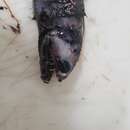Diagnostic Description
(
Inglês
)
fornecido por Fishbase
Body black in color, lacks well developed pale patches (Ref. 3982). Lack of high arch in photophores behind anal base and presence of double postorbital organ (Ref. 37473).
- licença
- cc-by-nc
- direitos autorais
- FishBase
- Recorder
- Cristina V. Garilao
Migration
(
Inglês
)
fornecido por Fishbase
Oceanodromous. Migrating within oceans typically between spawning and different feeding areas, as tunas do. Migrations should be cyclical and predictable and cover more than 100 km.
- licença
- cc-by-nc
- direitos autorais
- FishBase
Morphology
(
Inglês
)
fornecido por Fishbase
Dorsal spines (total): 0; Dorsal soft rays (total): 9 - 13; Analspines: 0; Analsoft rays: 12 - 17
- licença
- cc-by-nc
- direitos autorais
- FishBase
- Recorder
- Cristina V. Garilao
Trophic Strategy
(
Inglês
)
fornecido por Fishbase
An oceanic and mesopelagic species usually found deeper than 500 m during the day. Feeds on midwater fishes and crustaceans.
- licença
- cc-by-nc
- direitos autorais
- FishBase
- Recorder
- Drina Sta. Iglesia
Biology
(
Inglês
)
fornecido por Fishbase
An oceanic and mesopelagic species usually found deeper than 500 m during the day (Ref. 2802). Feeds on midwater fishes and crustaceans (Ref. 2802).
- licença
- cc-by-nc
- direitos autorais
- FishBase
Large-eye snaggletooth
(
Inglês
)
fornecido por wikipedia EN
The large-eye snaggletooth (Borostomias antarcticus), also called the straightline dragonfish or Antarctic snaggletooth,[3] is a species of fish in the family Stomiidae (barbeled dragonfishes).[4][5][6][7]
Description
The large-eye snaggletooth is black in colour, up to 35 cm (14 in) in length.[8] It has 9–13 dorsal soft rays and 12–17 anal soft rays. It is identified by the lack of high arch in the photophores behind the anal base, presence of double postorbital organ and the clear separation of the dagger-like teeth in its upper jaw.[9][10][11] It has 40–60 lateral photophores extending along its belly and positioned in two straight lines.[9]
Habitat
The large-eye snaggletooth is bathydemersal and mesopelagic, staying below 500 m (1,600 ft) during the day, sometimes as deep as 2,500 m (8,200 ft). It is found in oceans worldwide.[12]
Behaviour
The large-eye snaggletooth feeds on mysids, bony fish and crustaceans.[13]
References
-
^ Harold, Anthony (May 10, 2013). "IUCN Red List of Threatened Species: Borostomias antarcticus". IUCN Red List of Threatened Species.
-
^ "WoRMS - World Register of Marine Species - Borostomias antarcticus (Lönnberg, 1905)". www.marinespecies.org.
-
^ "Borostomias antarcticus". fishesofaustralia.net.au.
-
^ "WoRMS - World Register of Marine Species - Borostomias antarcticus (Lönnberg, 1905)". www.marinespecies.org.
-
^ "Travaux de la Station marine de Villefranche-sur-Mer". Station marine de Villfranche-sur-Mer – via Google Books.
-
^ Smith, Margaret M.; Heemstra, Phillip C. (December 6, 2012). Smiths' Sea Fishes. Springer Science & Business Media. ISBN 9783642828584 – via Google Books.
-
^ Morgan, M. D. (December 6, 2012). Ecology of Mysidacea. Springer Science & Business Media. ISBN 9789400980129 – via Google Books.
-
^ "Marine Species Identification Portal : Borostomias antarcticus". species-identification.org.
-
^ a b "Large-eye Snaggletooth - Borostomias antarcticus". www.arctic.uoguelph.ca.
-
^ "Borostomias antarcticus, Snaggletooth". www.fishbase.se.
-
^ Bigelow, Henry B.; Cohen, Daniel M.; Dick, Myvanwy M.; Jr, Robert H. Gibbs; Grey, Marion; Jr, James E. Morrow; Schultz, Leonard P.; Walters, Vladimir (October 23, 2018). Soft-rayed Bony Fishes: Orders Isospondyli and Giganturoidei: Part 4. Yale University Press. ISBN 9781933789279 – via Google Books.
-
^ "Borostomias antarcticus (Snaggletooth)". descna.com.
-
^ "Food Items - Borostomias antarcticus". www.fishbase.se.

- licença
- cc-by-sa-3.0
- direitos autorais
- Wikipedia authors and editors
Large-eye snaggletooth: Brief Summary
(
Inglês
)
fornecido por wikipedia EN
The large-eye snaggletooth (Borostomias antarcticus), also called the straightline dragonfish or Antarctic snaggletooth, is a species of fish in the family Stomiidae (barbeled dragonfishes).
- licença
- cc-by-sa-3.0
- direitos autorais
- Wikipedia authors and editors
Diet
(
Inglês
)
fornecido por World Register of Marine Species
Feeds on fishes and crustaceans
North-West Atlantic Ocean species (NWARMS)
- licença
- cc-by-4.0
- direitos autorais
- WoRMS Editorial Board
Distribution
(
Inglês
)
fornecido por World Register of Marine Species
Greenland south to Bay of Biscay including western Mediterranean; elsewhere, Southern Ocean from 35°S to 65°S.
North-West Atlantic Ocean species (NWARMS)
- licença
- cc-by-4.0
- direitos autorais
- WoRMS Editorial Board
Habitat
(
Inglês
)
fornecido por World Register of Marine Species
Occasionally found in Canadian Atlantic waters. Found to depths greater than 500 m in the day.
North-West Atlantic Ocean species (NWARMS)
- licença
- cc-by-4.0
- direitos autorais
- WoRMS Editorial Board
Habitat
(
Inglês
)
fornecido por World Register of Marine Species
nektonic
North-West Atlantic Ocean species (NWARMS)
- licença
- cc-by-4.0
- direitos autorais
- WoRMS Editorial Board

